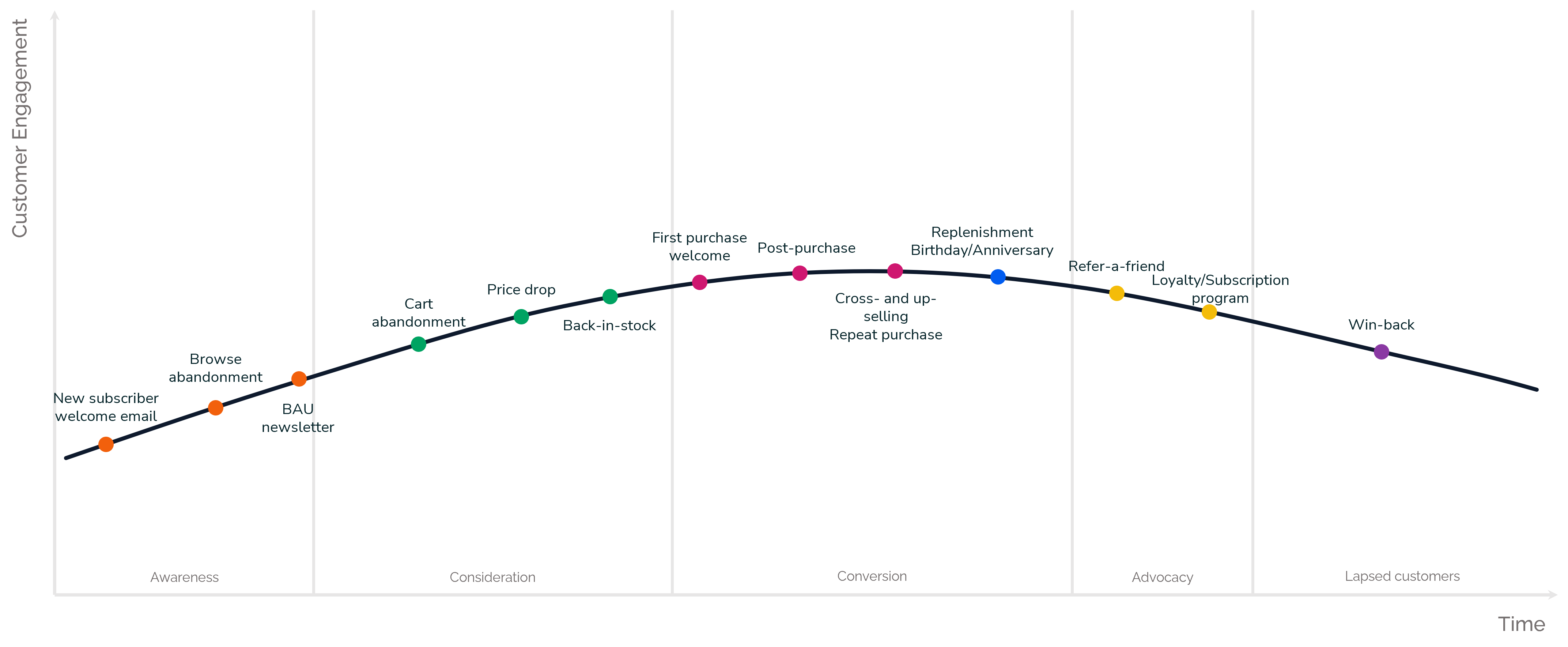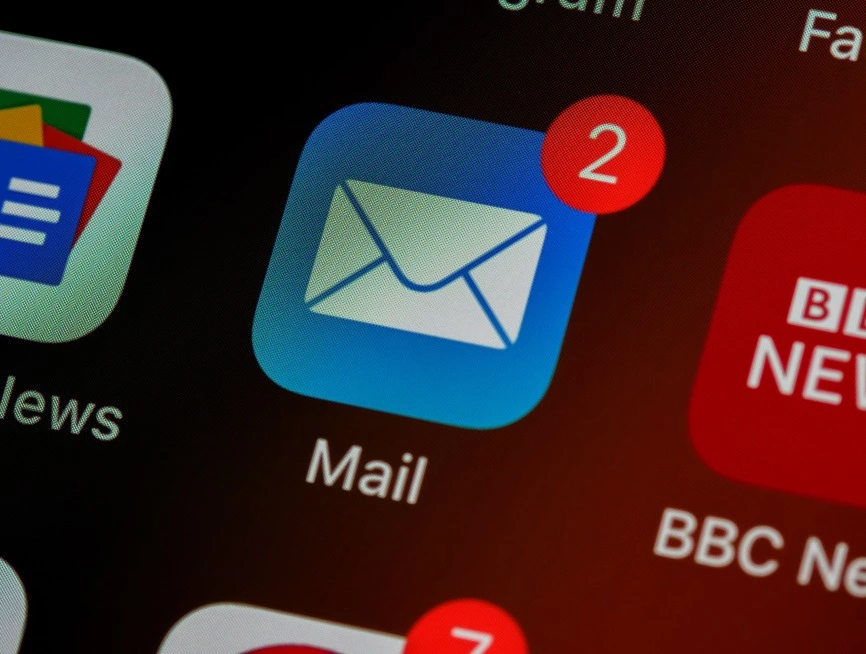It remains 6-7 times more expensive to acquire new customers than retaining customers. With email being the main driver of customer retention, it’s no wonder this is a vital part of your digital marketing strategy.
But how do you keep retaining customers at every step of the way? In other words, how do you keep your customers engaged throughout the entirety of your lifecycle marketing?
Having automated and personalized email lifecycle marketing could help you retain customers with minimal effort.
When we talk about lifecycle marketing, we are talking about each point a customer goes through, from being a prospective customer to loyalty, and even to becoming a lapsed customer. This is explained in the image below.

Lifecycle stages explained
The next section will explain each of the lifecycle stages and describe possible triggered emails to go with them to maximize retention.
Awareness
This is the very first stage of the marketing lifecycle. At this point, customers have just become aware of your existence – whether it is through googling a problem your products solve, an advert on social media, some kind of word of mouth, etc.
In any case, it has brought them to your website.
There are several types of emails you could send to your prospective customers at this stage. All of these email marketing tactics work well for both retail and travel.
Welcome email
Welcome emails are likely the first emails your customers will receive. Use it to introduce your brand. Make sure you come across as friendly and inviting, and don’t make the email too salesy.
You can use social proof, such as ratings & reviews and user-generated content and social feeds in your email to help your customers gain trust in your brand.
Another tactic you can make use of is geotargeting, by showing customers their closest brick-and-mortar store or branch.
Browse abandonment
Browse abandonment emails occur when a high intent customer leaves your website without carting anything. They should include product recommendations based on the customer’s previous behavior. This could help customers find what they were originally looking for, or remind them of their search that got abandoned due to distractions.
Cart abandonment
Cart abandonment technically sits between the awareness and consideration stage because, at this point, your prospective customer has already carted an item. Much like with browse abandonment, though, they have abandoned the website before buying anything.
Like with welcome emails, a good tactic to employ in these emails is social proof. This can help ease purchase anxiety, increasing the chances of customers returning to your site and purchasing.
Make sure that there is a CTA in your email that leads back to your website with the cart filled where your customers last left off to avoid frustration.
If you want to learn more about cart and browse abandonment, this article gives you the 10 best practices for your cart and browse abandonment emails.
Consideration
At this stage of email lifecycle marketing, your customer is actively considering purchasing from your brand. A small nudge in the right direction may convince them to buy from you.
The following emails are useful for both retail and travel businesses.
Price drop
Price drop emails are emails triggered when an item that a customer has browsed has dropped in price.
They can be good tactics to convince impulse buyers and price-conscious shoppers to make a purchase from you. When you do use them, though, make sure you have your segments set up correctly. Those higher value customers should not receive these emails, and nor should customers who haven’t viewed the product or trip at all.
Back in stock
Back in stock emails are triggered when a product or trip, which was viewed by a customer when it was out of stock, is back in stock.
By allowing prospective customers to fill in their data on an out-of-stock page, you are able to send these emails directly to them. It also allows you to collect data about these customers and make the touchpoints during their lifecycle more personalized.
Low stock
Has a potential customer recently looked at an item or trip that is now low in stock? Set up low stock emails! These emails work because of the feeling of FOMO (Fear of Missing Out), encouraging customers to speed up the checkout process.
Wishlist abandonment
When customers start setting up their wishlist, but abandon it before finishing, you can send them an email about it.
Ensure that you don’t sound too creepy or forward in these emails, but instead friendly. Unless, of course, your brand is about being creepy.
App download invite
If you have a mobile app, why not share it with your customers? Send them an invite link to your app. You could even reward them with loyalty points, for example.
Conversion
At this stage of the customer lifecycle, they have made their first purchase. It is now time to make a good lasting impression and foster that loyalty.
The following triggered emails work well for both travel and retail.
Post-purchase
When a customer has made a purchase on your website, sending a post-purchase message can be key to help them progress into the loyalty part of the lifecycle.
Post-purchase emails can contain anything from product information and guides, to recommendations and shipping information. For travel businesses specifically, you can email customers their booking confirmation, or use a countdown timer in your email counting down to their trip.
Another key tactic to use in these emails is to encourage reviews for product feedback, or even UGC (user-generated content) from the trip your customer went on. The options are endless.
Cross- and up-selling
Why not email your customers with some extra possible purchases to ‘complete the look’ or ‘upgrade to business class’ by using product recommendations? With these emails, you can increase your AOV (average order value).
Advocacy
This is the stage you want all your customers to eventually reach. Your customers here are happy, and more likely to spread positive word of mouth. Help them become ambassadors for your business by using these emails.
Loyalty program
Having a loyalty scheme in place can be a great way to keep your customers engaged. Once it’s working, you can send personalized emails to your customers, reminding them how many points they have earned. You can even include recommendations based on what their points may help them buy.
Repeat purchase
You can reward your customers with discounts and coupon codes for specific repeat purchases. For example, if a customer just came back from a trip they booked with you, you could offer the same trip again.
Birthday/anniversary
Birthday emails get 481% higher transaction rates than other promotional emails. If you have this data available for your customers, why not send them a message on their birthday with a coupon code?
If you don’t have their birthday, you could use an anniversary from when they first subscribed to you. For travel businesses, you could even send an anniversary email every year after their booked holiday.
Refer a friend
Having a ‘refer a friend program’ can help you grow your database – and therefore, your business! Give your customers an incentive, though. You could, for example, give them a certain amount of money off their next purchase with you, or give them extra loyalty points.
Subscription program
If suitable to your company, you could offer a subscription program. This will allow customers to receive emails and rewards from you, in return for some zero-party data that you can then use to optimize your personalization. Win-win.
Replenishment (retail specific)
Replenishment emails are useful if you sell products that customers will run out of and need to buy again. Test and optimize your email to see when the best timing is to send it to customers after their purchase.
Lapsed customer
The last stage is the dreaded lapsed customer – a customer who has bought from you previously but no longer interacts with your brand. Not all is lost, though. There is one kind of email you can send them to win back their hearts.
Customer win back
These emails must show your lapsed customers that you still value them. Make sure they’re still personalized, with product recommendations and dynamic content suitable to them.
You can add a coupon code to these emails, but make sure you do so wisely. Ensure that you are only sending these to truly lapsed customers – not those who will come back later regardless of your email.
However, you should also make sure that you don’t wait too long to send an email. You want customers to remember who you are. Test and optimize the sweet spot for your business.
Final thoughts
Hopefully, these tactics have inspired you to optimize your lifecycle email marketing.
If you’re looking for more email marketing inspiration, check out our Types of triggered emails you should be using checklist.






